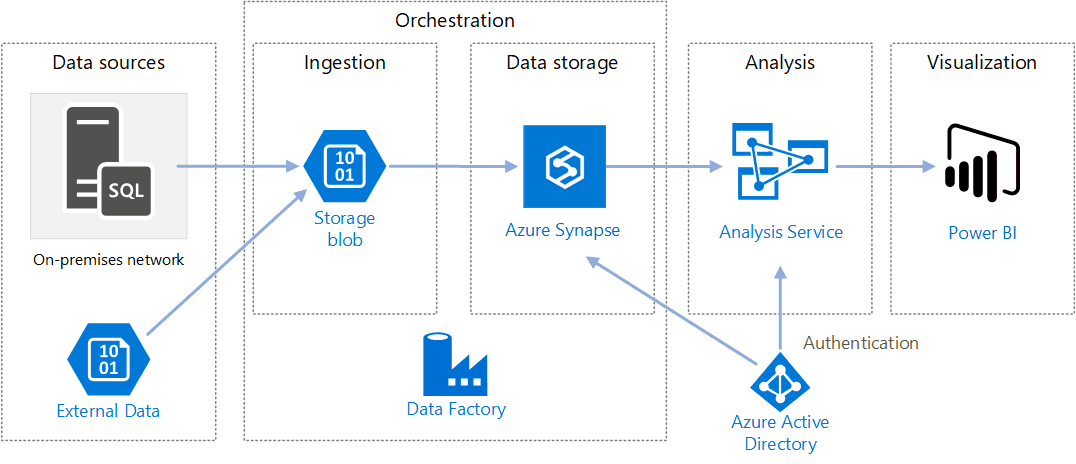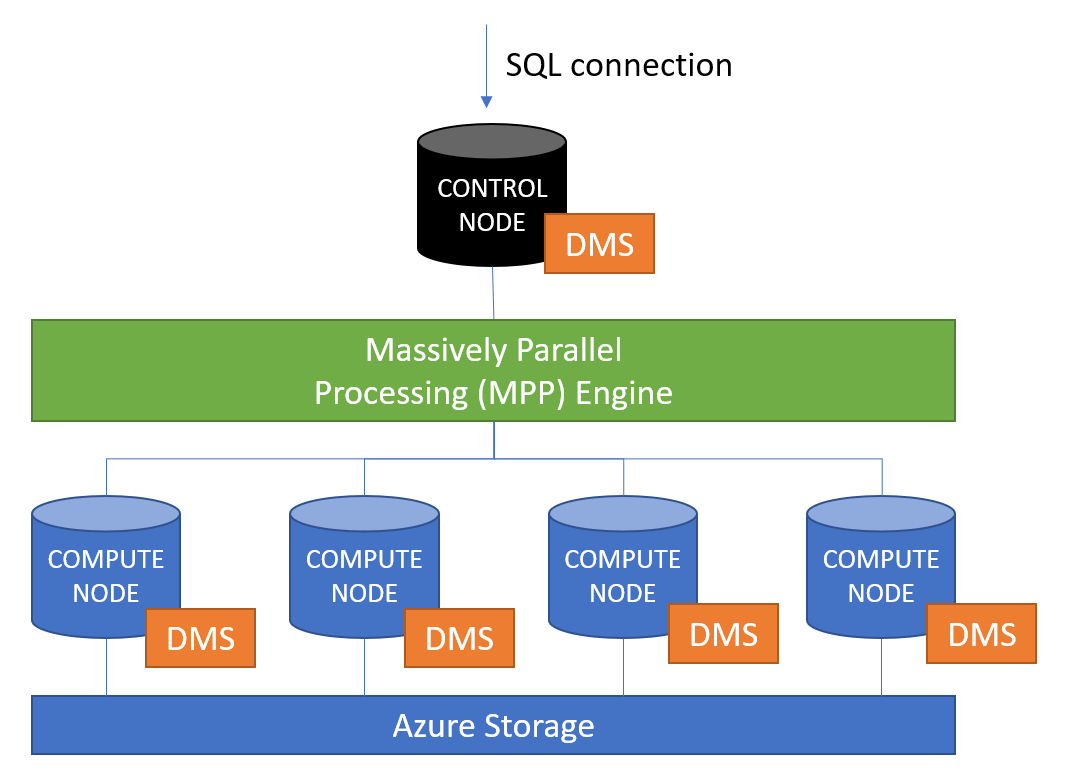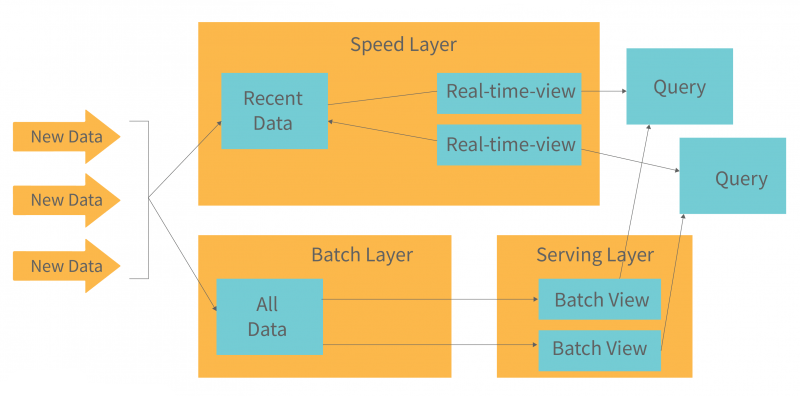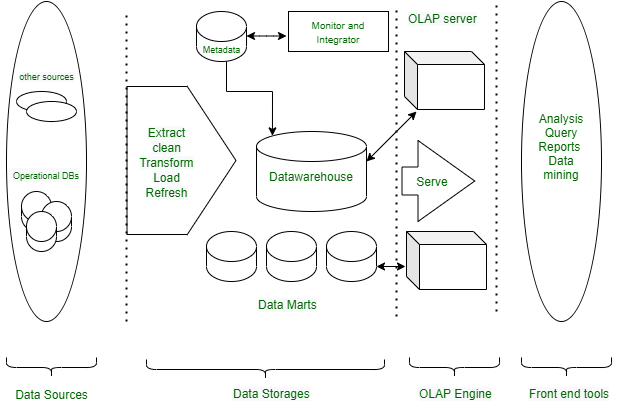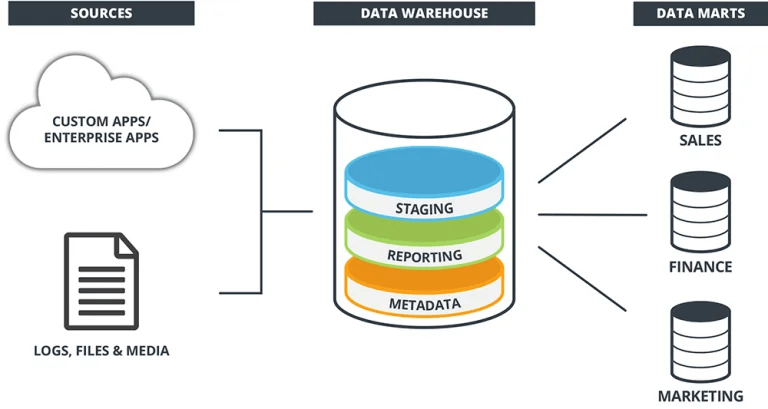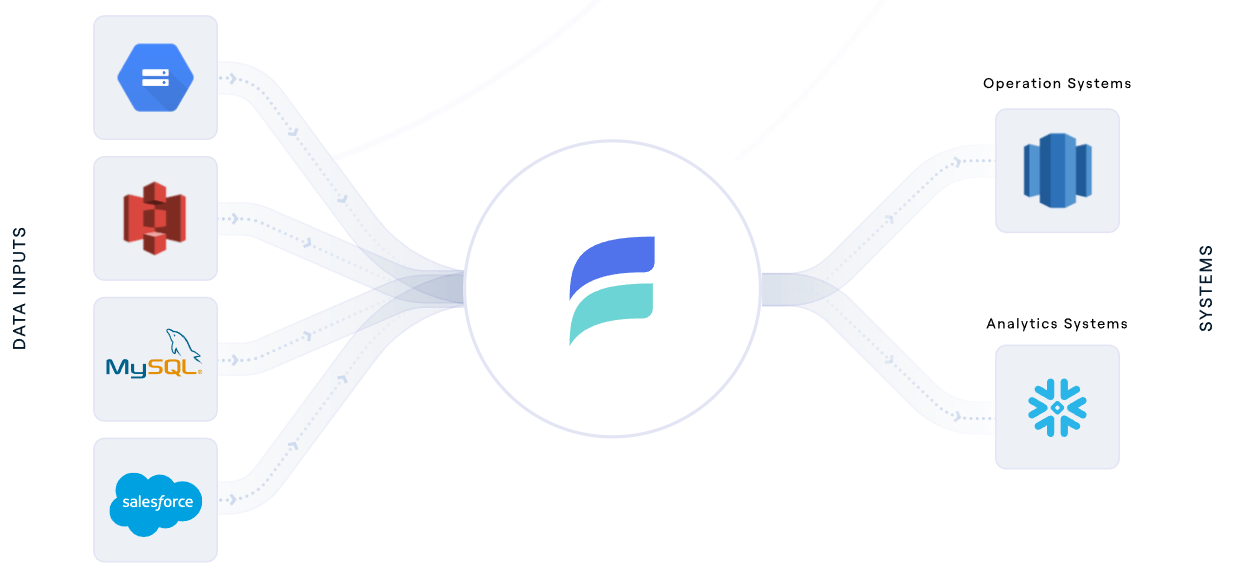
Innovative, phenomenal, revolutionary – whatever you may call a modern data warehouse, the gist is that they are a whole new level of impressive. What's really striking is the visibility and transformation they bring to the data management perspective.
This transformative power of modern data warehouses is further highlighted by the fact that the data warehousing market reaching $51 billion by 2028 is an indication of how important these data playgrounds became and will be in the future.
So, what is a modern data warehouse and how does it stand out from the traditional versions? This article is your compass to navigating their functions, architecture, components, and real-world applications that underscore their pivotal role in modern business environments.
What Is A Modern Data Warehouse?
A data warehouse holds information collected from many different sources. This information is pulled from transactional systems, operational data stores, and outside sources. The purpose is to bring data together in one location to provide a company-wide view for analyzing and reporting data.
In recent years, many companies have shifted from old-fashioned data storage on their premises to a more modern data stack in the cloud. This helps them handle the increasing need for analyzing and storing growing data. This change is known as the modernization of data warehouses or a modern data warehouse.
These modern data warehouses use cloud technology to deliver a data management system that's flexible and powerful. These warehouses are not only about storing data. They process different data types to get insights.
Functions Of A Modern Data Warehouse
Let's explore some of the important functions of a modern data warehouse.
Data Integration & Consolidation
Modern data warehouses integrate and consolidate data from various sources, like operational systems, databases, social media feeds, and IoT devices. The data can be structured, semi-structured, or unstructured. It is then cleaned and organized into a unified repository. This gives a full picture of the business which can help make smarter decisions.
Data Storage & Management
These warehouses are built to handle and store lots of historical data in one central system. They take care of transforming and cleaning data to get rid of redundancies or inconsistencies while maintaining the quality and security of the data. This effective data management makes the contents of the warehouse reliable, secure, and easy to understand.
Data Processing & Real-Time Capabilities
Modern data warehouses have powerful data processing capabilities that let them quickly handle large amounts of data. Real-time processing provides immediate analysis of data as it comes in. This way, businesses can monitor customer behavior, keep track of marketing campaigns, or spot fraud as it happens.
Advanced Analytics
Modern data warehouses support advanced analytical methods, like machine learning, statistical models, and complex data mining. This helps predict future trends, identify patterns, and pull out hidden insights for a better understanding of operations, customers, and markets.
Data Reporting
Modern warehouses generate detailed reports and dashboards to present data in an understandable format. Customizable for the needs of different departments and stakeholders, these reports provide performance tracking, progress monitoring, and informed decision-making.
Breaking It Down: Traditional vs. Modern Data Warehouses
Data warehouses have changed a lot over time. But what makes a “modern” data warehouse different? Let’s take a look at how modern warehouses differ from traditional, on-premises data warehouses:
- Speed: Modern data warehouses offer faster processing speeds than their traditional counterparts.
- Cost: Modern warehouses are often more cost-savvy than traditional ones because of their pay-as-you-go cloud computing model.
- Purpose: Traditional warehouses are built for specific workloads and data types. Modern warehouses, on the other hand, can handle high volumes of diverse data.
- Scope: The scope of traditional warehouses is often limited to areas like business intelligence whereas modern warehouses extract insights from a wide range of data.
- Location: Traditional data warehouses are typically on-premise while modern ones use the cloud. This gives modern data warehouses advantages in terms of flexibility and scalability.
- Data sources: Traditional warehouses source data from conventional databases. On the other hand, modern warehouses handle different sources including social media, sensors, and multimedia.
10 Key Characteristics Of Modern Data Warehouses
Here are 10 major features that make modern data warehouse more adaptable, efficient, and powerful.
Scalability
Modern data warehouses can handle increasing data volumes without compromising performance. They are designed to grow with the data needs of an organization.
Real-Time Analysis Support
They can process and analyze real-time data to provide businesses with timely insights.
Advanced Analytics Support
They support advanced analytics tools and techniques. This lets you derive more complex insights from their data.
Robust Security
Modern data warehouses provide advanced security measures to protect sensitive data.
Governed Access
They offer governed access to data and only authorized users can access and use the data.
Simultaneous user support
Modern data warehouses can serve a large number of users simultaneously without compromising performance.
Flexibility
They are flexible enough to support different business needs, including different types of users, load operations, refresh rates, deployments, data processing engines, and pipelines.
Collaboration
Modern data warehouses support collaboration between IT and business users. This shared responsibility for data acquisition and transformation makes the data warehousing process more efficient.
Simplicity
Despite their advanced features, modern data warehouses strive for simplicity. They limit data movement and duplication and advocate for a uniform platform.
Resilience
They provide high availability, disaster recovery, and backup/restore capabilities so that the data is always accessible and secure.
Modern Data Warehouse Architecture & Important Components
The modern data warehouse architecture consists of many different key components that ingest, process, and deliver data meaningfully. Let’s dive in.
Components Of A Modern Data Warehouse
Here are some of the major components of modern data warehouses:
Database
The database is the most important element of a modern data warehouse. It serves as a vast reservoir that stores all the data from different sources and makes it available for analysis and reporting.
Extraction, Transformation, and Loading tools (ETL)
ETL tools perform a triple function: extracting data from various sources, transforming it into an appropriate format, and loading it onto the target database.
Metadata
Think of metadata as the 'data about data.' It gives structure to the data warehouse, guiding its construction, maintenance, and use. It has 2 types:
- Business metadata provides a user-friendly view of the information stored within the data warehouse.
- Technical metadata helps data warehouse designers and administrators in development and management tasks.
Access Tools
Acting as a link between users and databases, these access tools simplify the data interpretation process and help extract meaningful insights. Some common types are:
- Data mining tools
- Query and reporting tools
- Application development tools
- Online Analytical Processing (OLAP) tools
Data Marts
Data marts serve particular business functions, offering an access level to deliver the data to users. They create a partition of data, providing faster and easier access for a specific set of users.
Exploring The Architectures Of A Modern Data Warehouse
Unlike traditional data warehouses with set architecture, modern data warehouses are dynamic, adapting to varying use cases and data needs. Here's an overview of the different architectural styles they can adopt.
Massively Parallel Processing (MPP) Architectures
In this architecture type, data processing gets distributed across multiple servers or nodes, and the queries are executed in parallel which improves query performance and scalability. This helps modern data warehouses handle big data workloads and deliver real-time or near-real-time analytics.
The key components of MPP architectures in modern data warehouses typically include:
- In-Memory Processing: Data is loaded and processed directly in memory to accelerate query performance.
- Compression: It uses compression techniques to reduce storage requirements and improve data retrieval speeds.
- Load Balancing: Query workload is evenly distributed across nodes to prevent individual nodes from getting overloaded.
- Distributed Storage: Data is stored across multiple nodes in a distributed fashion where each node contains a portion of the data.
- Massively Parallel Query Execution: Queries are divided into smaller tasks and each task is processed in parallel across multiple nodes.
- Shared-Nothing Architecture: Each node operates independently with its own computing resources (CPU, memory, storage) and doesn’t share any resources.
- Columnar Storage: It uses columnar storage formats which store data by columns rather than rows. This enhances query performance as only relevant columns need to be read, reducing I/O operations.
- Query Optimization: MPP architectures use sophisticated query optimization techniques to analyze the query and determine the most efficient way to distribute and execute the workload across nodes.
Lambda Architectures
The Lambda architecture consists of 3 main layers.
- Batch Layer: This layer handles large-scale, fault-tolerant batch processing of data. It ingests and stores all the data coming into the system and performs batch processing on the entire data set. The batch layer generates detailed views of historical data that do not require real-time updates.
- Speed Layer: The speed layer provides real-time processing and handles the data streams that require low-latency processing. It processes the most recent data and produces incremental updates to the data views that the batch layer has generated by the batch layer.
- Serving Layer: The serving layer combines the results from both the batch and speed layers to provide a unified view of the data. It serves the query results to end-users or applications to access both historical and real-time data.
Multi-Structured Data Architectures
With multi-structured data architecture, data warehouses can ingest, store, and process data in different formats for more comprehensive and flexible data analysis.
Here are some key components and features of multi-structured data architectures in modern data warehouses:
- Data Lake Integration: Multi-structured data architectures use data lakes as a central repository for storing raw and unprocessed data.
- NoSQL Databases: It incorporates NoSQL databases that can handle data in various formats, like JSON, XML, key-value pairs, and document-oriented structures.
- Extract, Load, Transform (ELT): The ELT approach is preferred over the traditional Extract, Transform, Load (ETL) approach for better handling of diverse data types.
- Schema-on-Read: It adopts a "schema-on-read" approach where the data is stored as-is in its raw form and the schema is applied or interpreted at the time of querying or analysis.
- Polyglot Persistence: A combination of relational databases, NoSQL databases, and data lakes can be used to store structured, semi-structured, and unstructured data, respectively.
Hybrid Architectures
Hybrid architecture is a combination of the traditional on-premises data warehouses and the cloud data warehouse models. In this approach, you can use both on-premise and cloud-based solutions to store, manage, and analyze their data. This integration gives you a more balanced and optimal solution where you benefit from the strengths of each approach while mitigating its weaknesses.
Hybrid architecture lets you keep critical or sensitive data on-premise because of security or compliance concerns. You can also store less sensitive or larger datasets in the cloud while distributing their data processing workloads. Real-time analytics on data can be performed in the cloud while running specific batch processing jobs on the on-premise data warehouse.
One major advantage of hybrid architectures is the ability to "burst" into the cloud when there is a sudden increase in demand. If the on-premise infrastructure is reaching its limits, the cloud resources are used to handle peak workloads.
2 Real-World Examples Of Modern Data Warehouses
Let's look at a few examples of companies that have adopted modern data warehouse solutions to consolidate data, enable advanced analytics, and provide valuable business insights.
1. A British Global FMCG Company
A British global FMCG organization, with an active presence in over 100 countries, faced the challenge of handling an immense volume of multi-structured data from diverse sources. These sources included organizational data, weblogs, social media, multimedia, spatial and GPS data, and information from devices and sensors.
On top of integrating this vast data, the company wanted to incorporate data virtualization and cloud integration capabilities. They needed an architecture that was both scalable to accommodate growing needs and agile in delivery.
Solution
The solution to this complex problem was the implementation of a modern enterprise data warehouse featuring multi-platform architecture in a hybrid environment.
Key steps included:
- The growth and expansion of the existing data warehouse into a modern variant.
- The creation of a new partitioning, addressing aspects such as in-memory structures, Massively Parallel Processing (MPP), and clustered column store indexes.
- Introducing complementary storage and analytics tools in a hybrid infrastructure equipped with data virtualization functionalities.
- The establishment of data marts to support the in-memory model with a master data capability that communicated with the data warehouse.
- The design of a scalable solution with the potential to incorporate a data lake to back up historical data in the data warehouse.
Benefits
Key benefits included:
- It helped with data experimentation – a critical aspect of a cross-functional data-driven organizational culture.
- Advanced analytics and self-service reports and models improved operational reporting and historical analysis.
- The hybrid architecture integrated data from various sources, both cloud-based, like social media and Customer Relationship Management systems, and on-premises, like sales or inventory management systems.
2. A Printing & Imaging Equipment Manufacturer
A leading manufacturer of printers and imaging equipment was facing challenges with its existing data management system, a Hadoop-based big data solution. The company's considerable data size of 2.7 terabytes had made the existing data management process expensive, slow, and inefficient.
The critical problem was the execution time of scoring models which took more than 50 hours – an untenable duration for a company dealing with substantial data daily.
Solution
The company adopted a framework for its new warehouse that supported data ingestion of raw and compressed data. Importantly, they applied a structured method for data transformation and modeling which allowed them to manage their large datasets effectively.
In the new solution, key features included:
- Structured data transformation and modeling.
- Data ingestion support for both raw and compressed data.
- A scalable, robust, and high-performance data warehouse.
- Advanced code maintenance, testing, and team collaboration platform.
Benefits
The implementation of a modern data warehouse transformed the company's data management operations. The benefits of the transition became apparent quickly:
- The cloud solution was cost-effective and projected to reduce yearly maintenance costs by 66%.
- The execution time of scoring models was reduced from over 50 hours to less than 15 minutes.
- The introduction of the new data warehouse proved to be scalable as it could manage 2.7 terabytes of data effectively.
Enhancing Data Pipelines: The Power Of Estuary Flow And Modern Data Warehouses
Estuary Flow is our dynamic solution designed to modernize data flow in real time, revolutionizing how data pipelines are handled in businesses. It provides a platform for the seamless capture, transformation, and movement of data.
With Flow, you can set up real-time ETL pipelines and CDC processes, offering superior speed, accuracy, and reliability in data replication and migration. Here’s how Estuary Flow helps you streamline your workflow and elevate your data pipeline:
- Scalable architecture: Built on a distributed architecture, Flow scales to handle high volumes of real-time data.
- Real-time processing: With low-latency data streaming, Flow empowers real-time analytics and provides up-to-the-minute insights to data analysts.
- Reliable data movement: Flow provides robust CDC, fault tolerance, and cross-region resilience. This reliability guarantees continuous data flow into the data warehouse.
- Real-time data transformation: It allows continuous data transformation via streaming SQL and JavaScript. This enables real-time ETL, aligning raw data to the data formats needed in the data warehouse.
- Seamless data ingestion: Flow provides real-time data ingestion from diverse sources like databases, SaaS apps, and IoT devices. This aligns with the key need of modern data warehouses – to consolidate and integrate data from multiple systems.
Checkout top modern data integration tools for seamless connectivity.
Conclusion
With the adoption of modern data warehouses, we've seen a whole new era of data democratization emerge. This sled to a data-driven culture – a far cry from the old days when only a select few could do data analysis. Now decision-makers and stakeholders at all levels can get their hands on timely and relevant information.
Looking ahead, it's pretty clear that the modern data warehouse will keep evolving along with the ever-changing nature of data. The future is looking exciting.
At Estuary, we will make this even more exciting. Our advanced DataOps tool, Flow, offers features like real-time ETL, instantaneous data transformation, and integration from numerous sources. These capabilities can help you resolve data flow obstacles and tap into the full power of your data analytics.
To explore how Estuary Flow can complement your modern data warehouse, sign up for a free account today.

Author
Popular Articles





